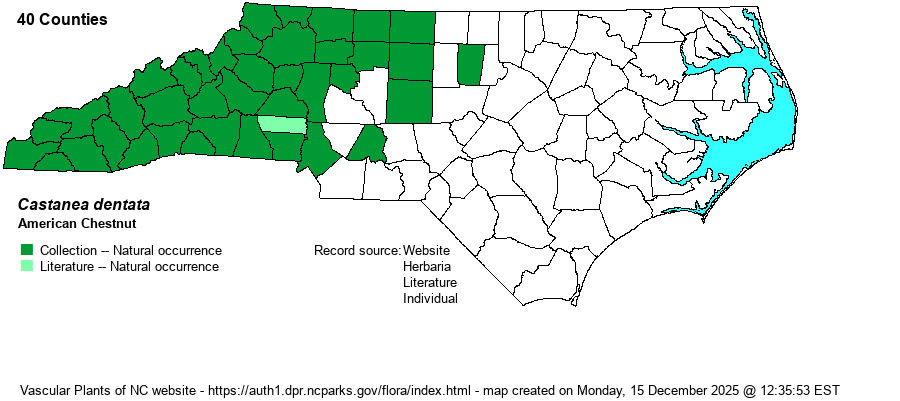| Author | (Marshall) Borkhausen | |
| Distribution | Throughout the Mountains and the western half of the Piedmont, including away from the foothills; ranges eastward to Orange and Randolph counties above the Fall Line. Records into the Coastal Plain are considered non-native occurrences.
Throughout most of the Appalachians and Piedmont, ranging from ME and WI south to central GA, western FL, and southern MS. Scarce in the Coastal Plains except in AL and MS, and not widespread in the western Great Lakes states.
| |
| Abundance | Formerly, before the chestnut blight hit in the 1920’s-1930’s, it was a very common and dominant montane tree. Today, it is still common in the Mountains, but only as stump sprouts and saplings; seldom reaches the age to produce fruit before dying. Fairly common in the foothills, but uncommon in the lowlands of the central Piedmont, to rare along the eastern edge. As in the Mountains, Piedmont individuals are almost only seen as stump sprouts and very young trees. In late 2022, the NCNHP added the species to its Watch List at W5, strongly declining, and they moved the State Rank up to S3 (from S4). Note that NatureServe also moved its Global Rank from G4 to now G3, indicating a continued decline. | |
| Habitat | This is a tree of somewhat xeric to mesic upland sites, but also occurs in rocky sites. In the mountains and foothills it is most numerous in Montane Oak-Hickory Forests but it also is found in Acidic Cove Forests and other dry to mesic sites over acidic soils, often where rocky. In the central and eastern Piedmont, however, it is found more often in somewhat more mesic forests. |
| Phenology | Flowers in June and July, and fruits from September to October. | |
| Identification | Formerly, this was one of the largest and most majestic trees in NC, being a large tree growing to 80-90 feet tall. Now, about all one can hope to see is a sapling or small tree to about 20 feet tall. Thankfully, it is still frequently encountered when you are hiking in the mountains and foothills, and the long and narrow alternate, deciduous leaves are quite obvious. The leaves are quite large, often 6-8 inches long, about 3-4x as long as wide, with strongly and evenly toothed margins along the entire length of the elliptical leaves. The large, heavily “spiny” fruit are seldom seen today; they are a collector’s item if found, and they are about the size of a tennis ball. Only two other native NC species could really be confused with the species. Allegheny Chinquapin (C. pumila) has somewhat shorter leaves, with the shape more oblong (nearly parallel sides) and not as strongly toothed on the margins; it has much smaller fruit, barely the size of a large marble. The scarce Chinquapin Oak (Quercus muehlenbergii) grows on high pH soil, usually has wider leaves (about 2-3 times as long as wide), and more clustered leaves near the branch tips. Of course, if visible, it has small acorns. Several other oaks -- Chestnut (Q. montana) and Swamp Chestnut (Q. michauxii) -- have leaves with more rounded teeth and wider leaves, often obovate in shape. Note: Chinese Chestnut (C. mollissima) has escaped in Macon County and could be an identification issue; check Google and other references for distinctions. | |
| Taxonomic Comments | A hybrid of this species with the related Allegheny Chinquapin, named as Castanea x neglecta, occurs in the Southeast. Hopefully, it is too rare to cause any confusion, though it does have characters of both parent species.
| |
| Other Common Name(s) | Chestnut (without a modifier) | |
| State Rank | S3 | |
| Global Rank | G3 | |
| State Status | W5 | |
| US Status | | |
| USACE-agcp | | |
| USACE-emp | | |

